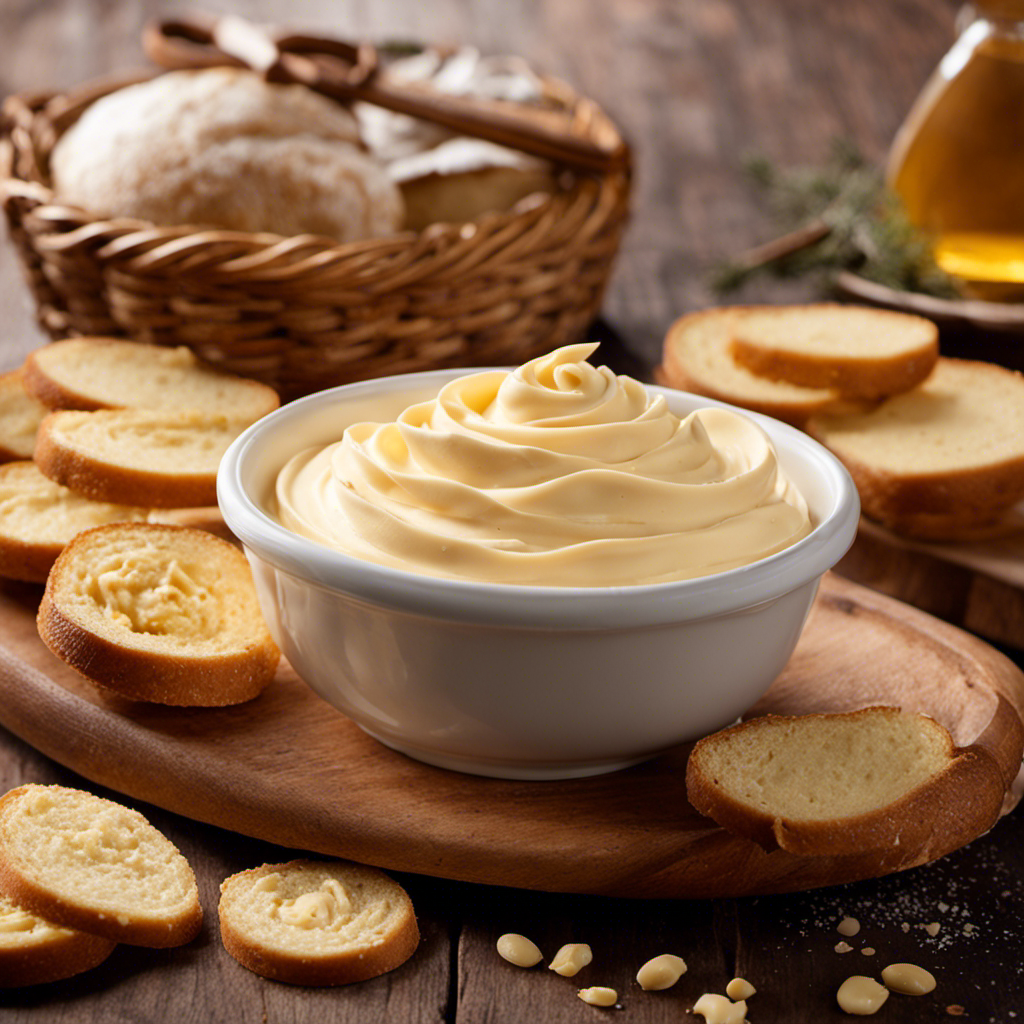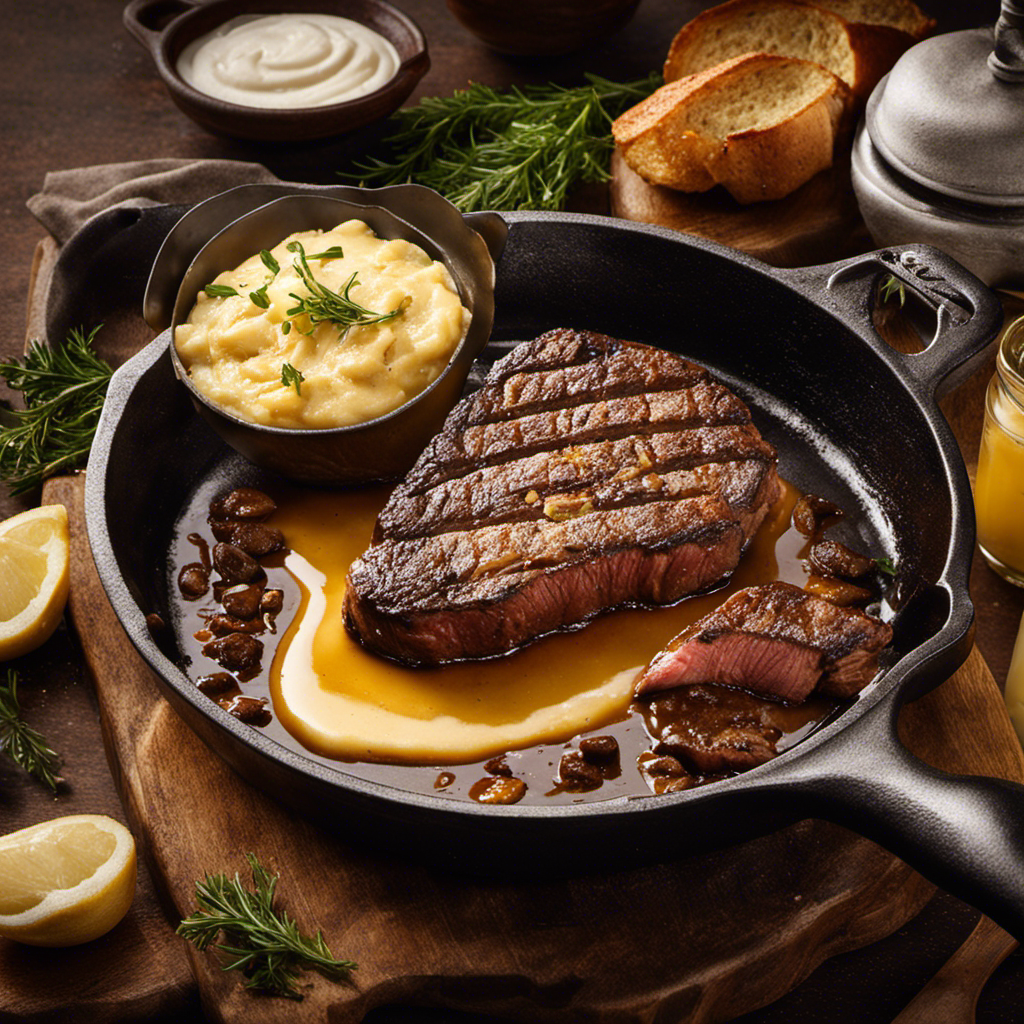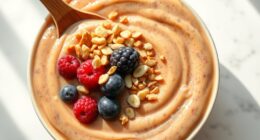I have to confess, everyone, Nigeria truly is the best place to find shea butter. This incredible product is more than just a regular beauty product, definitely not! It symbolizes a deeply rooted tradition that has been passed down from one generation to the next.
And let me tell you, the process of extracting shea butter here is a sight to behold. From the regions known for its production to the incredible women who make it all happen, this article will take you on a journey to discover the true origins of shea butter in Nigeria.
Get ready to be amazed!
Key Takeaways
- Shea butter is produced in various regions of Nigeria, including the Nigerian savannah, Kogi, Kwara, Oyo, and Ogun.
- Shea butter can be obtained through traditional hand extraction methods or mechanical extraction methods.
- Shea butter is rich in vitamins and fatty acids, making it beneficial for skincare.
- Shea butter production in Nigeria has significant economic and cultural importance, providing income and job opportunities while reflecting the country’s heritage.
The Origins of Shea Butter in Nigeria
You can find shea butter being produced in various regions of Nigeria. The extraction methods for shea butter in Nigeria have been passed down through generations. The most common method is the traditional hand extraction method. It involves collecting the shea nuts, drying them, and then pounding and grinding them manually to release the oils.
Another method is the mechanical extraction method, where machines are used to crush and process the shea nuts.
The benefits of shea butter in skincare are numerous. It is rich in vitamins A and E, which help to nourish and moisturize the skin. Shea butter also contains fatty acids that help to reduce inflammation and soothe dry and irritated skin. Its natural emollient properties make it an excellent ingredient for creams, lotions, and balms.
Overall, shea butter is a valuable and versatile resource that is deeply rooted in the culture and traditions of Nigeria.
Traditional Shea Butter Production Methods
When it comes to traditional shea butter production methods, there are several key points to consider.
First, the sourcing of shea nuts locally is vital to ensure the authenticity and quality of the final product.
Indigenous processing techniques, passed down through generations, involve handpicking, drying, roasting, and grinding the shea nuts before extracting the butter.
Additionally, sustainable production practices are crucial for the long-term viability of shea butter production, including reforestation efforts, fair trade partnerships, and empowering local communities.
Local Shea Nut Sourcing
To locally source shea nuts in Nigeria, you’ll typically find them harvested from the shea tree. Local sourcing of shea nuts is an important aspect of the shea butter production process as it has several benefits.
Firstly, it supports the local economy by creating job opportunities for the farmers and collectors involved in the harvest. This helps to improve livelihoods and reduce poverty in rural communities.
Secondly, local sourcing reduces the environmental impact of the shea butter industry. By sourcing shea nuts locally, transportation distances are minimized, thereby reducing carbon emissions and fuel consumption.
Additionally, local sourcing promotes sustainable farming practices as farmers are more likely to employ environmentally friendly methods when harvesting shea nuts.
Overall, local sourcing of shea nuts in Nigeria not only benefits the local economy but also contributes to a greener and more sustainable shea butter industry.
Indigenous Processing Techniques
Indigenous communities in Nigeria have developed unique and traditional techniques for processing shea nuts. These techniques have been passed down through generations and play a crucial role in the economic significance of shea butter production.
Here are four indigenous techniques used in Nigeria:
-
Hand picking: Shea nuts are carefully handpicked from the trees by skilled harvesters. This method ensures that only ripe nuts are collected, which guarantees the highest quality shea butter.
-
Sun drying: After harvesting, the shea nuts are spread out under the sun to dry. This natural drying process helps to remove excess moisture and prepare the nuts for further processing.
-
Roasting: Once the nuts are dry, they are roasted over an open fire. This step enhances the flavor and aroma of the nuts, giving the shea butter a distinct and rich taste.
-
Grinding and kneading: The roasted nuts are then ground into a fine powder and kneaded to extract the oils. This process requires skill and patience, as it determines the quality and texture of the final shea butter product.
These indigenous techniques not only preserve the cultural heritage of Nigeria but also contribute to the economic growth of local communities.
Sustainable Production Practices
If you want to support sustainable production practices, consider exploring alternative methods for processing nuts. Sustainable sourcing is crucial in reducing the environmental impact of the beauty and food industries. When it comes to nuts, there are several innovative techniques that can be used to ensure sustainability. One method is cold pressing, which involves extracting oils from nuts without using heat or chemicals. This preserves the natural properties of the nuts and reduces the carbon footprint of the process. Another approach is using solar dryers instead of traditional methods that require fossil fuels. Solar dryers harness the power of the sun to remove moisture from the nuts, eliminating the need for electricity and reducing greenhouse gas emissions. By adopting these sustainable production practices, we can contribute to a healthier planet and support the communities that rely on nut production.
| Method | Description | Benefits |
|---|---|---|
| Cold pressing | Extraction of oils from nuts without heat or chemicals | Preserves natural properties of nuts, reduces carbon footprint |
| Solar dryers | Use of solar energy to remove moisture from nuts instead of traditional methods that require electricity | Reduces greenhouse gas emissions, eliminates reliance on fossil fuels |
| Organic farming | Cultivation of nuts without the use of synthetic fertilizers or pesticides | Protects soil and water quality, promotes biodiversity, ensures a healthier product |
| Fair trade | Ensuring fair wages and working conditions for nut producers | Supports sustainable livelihoods, empowers local communities, promotes social justice |
Shea Butter Extraction Process in Nigeria
When it comes to the extraction of shea butter in Nigeria, traditional techniques have been used for centuries. These techniques involve manual labor and simple tools to extract the butter from the shea nuts.
However, with the increasing demand for shea butter and concerns about sustainability, there is a need to explore more efficient and eco-friendly extraction methods.
Additionally, the economic impact of shea butter extraction cannot be ignored, as it provides income and livelihood opportunities for many communities in Nigeria.
Traditional Extraction Techniques
You can easily find traditional extraction techniques for shea butter in Nigeria. These indigenous processing techniques have been passed down through generations and are still widely used today. Here are four key steps involved in the traditional extraction process:
-
Harvesting: Shea nuts are collected from the shea tree, which grows abundantly in the Nigerian savannah. The nuts are then sorted to remove any impurities.
-
Drying: The sorted nuts are spread out in the sun to dry for several days. This helps to reduce moisture content and prepare them for the next step.
-
Crushing and Roasting: Once dried, the nuts are crushed and roasted to release the oils. This is typically done using a mortar and pestle or a grinding machine.
-
Grinding and Kneading: The roasted nuts are ground into a paste and then kneaded to further extract the oils. This process involves adding water and continuously working the mixture until the oils separate.
These traditional extraction techniques highlight the rich cultural heritage of shea butter production in Nigeria. Transitioning into the next section on sustainability, it’s important to consider how these techniques can be preserved for future generations.
Sustainability of Shea Butter
The sustainability of traditional extraction techniques for shea butter in Nigeria relies on preserving these indigenous methods for future generations. These techniques have been passed down through generations and are deeply rooted in the Nigerian culture.
By continuing to use these traditional methods, we ensure the preservation of the environment and the fair trade practices that have been established over time.
Shea butter production provides significant economic benefits to local communities, particularly for women who are often the primary producers. Through fair trade practices, these women are able to earn a fair wage for their labor and contribute to the economic development of their communities.
It is crucial that we support and promote the sustainability of these traditional extraction techniques to ensure the long-term viability of the shea butter industry in Nigeria.
Economic Impact of Extraction
To fully understand the economic impact of extraction, it’s important to examine the financial contributions that come from preserving traditional techniques and supporting fair trade practices. Shea butter extraction not only provides economic benefits to the communities involved but also meets the market demand for natural and sustainable skincare products.
Here are four key reasons why the economic impact of shea butter extraction is significant:
-
Job creation: The extraction process requires manual labor, creating employment opportunities for local communities.
-
Income generation: Shea butter production allows individuals and cooperatives to earn a livelihood and improve their economic status.
-
Export revenue: Nigeria’s shea butter exports contribute to the country’s foreign exchange earnings.
-
Community development: The income generated from shea butter extraction can be reinvested in education, healthcare, and infrastructure, enhancing overall community development.
Understanding the economic benefits of shea butter extraction sets the stage for exploring the regions in Nigeria known for shea butter production.
Regions in Nigeria Known for Shea Butter Production
If you’re looking for regions in Nigeria known for shea butter production, one of the main areas to consider is the northern part of the country.
The traditional shea butter extraction methods have been passed down through generations in these regions, making them experts in the craft.
The shea butter market in Nigeria is thriving, with a high demand both domestically and internationally.
In the northern regions, the shea trees grow abundantly, providing a sustainable source of raw materials for shea butter production.
The local communities have perfected the art of extracting shea butter using traditional methods, which involve handpicking the shea nuts, drying and roasting them, grinding them into a paste, and then boiling and cooling the paste to obtain the valuable shea butter.
These regions are not only important for the production of shea butter but also contribute significantly to the economic growth and development of Nigeria.
The Role of Women in Shea Butter Production
Women play a crucial role in the production of shea butter in Nigeria, contributing to the economic growth and development of their communities. Here are four key ways in which women contribute to the shea butter industry in Nigeria:
-
Harvesting: Women are primarily responsible for collecting the shea nuts from the trees. They use their extensive knowledge of the local landscape and the timing of the shea nut ripening to ensure a successful harvest.
-
Processing: Women are skilled in the traditional methods of processing shea nuts into butter. They carefully sort, roast, grind, and knead the nuts to extract the precious butter, using their expertise to produce high-quality shea butter.
-
Trading: Women often take on the role of selling the shea butter in local markets or to larger-scale buyers. They negotiate prices, promote their products, and ensure a steady income for themselves and their families.
-
Entrepreneurship: Many women in the shea butter industry have started their own businesses. They not only produce shea butter but also create employment opportunities for others, contributing to the economic empowerment of their communities.
Through their involvement in shea butter production, women in Nigeria are not only preserving a traditional craft but also driving economic growth and empowering themselves and their communities.
Sustainability and Fair Trade Practices in Shea Butter Production
When choosing skincare products, you can support sustainability and fair trade practices by looking for certifications and labels that ensure ethical sourcing and production.
In the context of shea butter production, sustainable sourcing refers to the responsible and environmentally-friendly methods used to obtain raw materials. This involves promoting biodiversity, conserving natural resources, and minimizing negative impacts on the environment.
Additionally, fair trade practices aim to empower the local communities involved in shea butter production by providing them with fair wages, safe working conditions, and opportunities for economic growth.
The Economic Impact of Shea Butter in Nigeria
To truly understand the economic impact of shea butter in Nigeria, you should examine the various sectors that rely on its production and distribution. Here are four key points to consider:
-
Job creation: The shea butter industry provides employment opportunities for thousands of Nigerians, particularly in rural areas where the shea tree grows abundantly. From harvesting the nuts to processing the butter, there are multiple stages that require labor, contributing to local economic development.
-
Export earnings: Nigeria is one of the largest exporters of shea butter in Africa, with a growing market demand worldwide. The export of shea butter brings in significant revenue, boosting the country’s foreign exchange earnings and contributing to its overall economic growth.
-
Women empowerment: Shea butter production is predominantly carried out by women in Nigeria. By engaging in this industry, women gain economic independence and improve their livelihoods. The economic benefits extend beyond the individuals involved, as they often reinvest their earnings into education and healthcare for their families.
-
Value addition: Shea butter is not only used in the cosmetic industry but also in the food and pharmaceutical sectors. This diversification of usage increases the market demand for shea butter, creating new business opportunities and driving economic growth.
Frequently Asked Questions
How Is Shea Butter Used in Traditional Nigerian Cuisine?
Shea butter is commonly used in traditional Nigerian cuisine. It adds a rich, nutty flavor to dishes like soups, stews, and sauces. Additionally, Nigeria is known for its use of shea butter in skincare products for its moisturizing and healing properties.
What Are the Different Grades of Shea Butter and How Do They Differ?
Differentiating grades of shea butter depend on factors like color, scent, and texture. These variations are a result of the shea nuts’ origin, processing method, and quality. Shea butter properties include moisturizing, anti-inflammatory, and antioxidant effects.
Are There Any Health Benefits Associated With Using Shea Butter?
Are there any health benefits associated with using shea butter? Absolutely! Shea butter is known for its moisturizing properties, making it a popular choice for skincare. It can also help soothe inflammation and promote healing. Its uses are endless!
How Does Climate and Weather Conditions in Nigeria Affect Shea Butter Production?
The climate and weather conditions in Nigeria have a significant impact on shea butter production. The hot and dry climate is ideal for the growth of shea trees, and the dry season provides optimal conditions for the extraction of shea butter.
What Are the Challenges Faced by Women Involved in Shea Butter Production in Nigeria?
Challenges faced by women in shea butter production in Nigeria include limited access to finance, lack of modern equipment, and poor infrastructure. These challenges hinder economic impact and development in the industry.
Conclusion
In conclusion, shea butter is a valuable natural resource that is widely produced in Nigeria. With its origins deeply rooted in traditional methods of extraction, shea butter holds immense cultural and economic significance in the country.
It is interesting to note that Nigeria is the largest producer of shea butter in Africa, accounting for 57% of the continent’s total production. This statistic highlights the pivotal role Nigeria plays in the shea butter industry and emphasizes the importance of sustaining and supporting this vital sector for the country’s economy.










